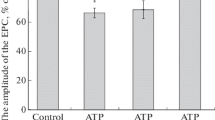Abstract
The effect of apamin, a polypeptidic toxin from bee venom which is a specific blocker of certain Ca2+-dependent K+ channels, has been tested (50–100nM) on voltage clamped single skeletal muscle fibres of the frog. The results have shown the existence of an inhibitory effect of the toxin on the slow outward K+ current which suggests the existence of a Ca2+-sensitive component of the slow K+ permeability in the plasma membrane of the frog muscle fibre.
Similar content being viewed by others
References
Adrian RH, Chandler WK & Hodgkin AL (1970) Slow changes in potassium permeability in skeletal muscle. J Physiol208: 645–668
Almers W & Palade PT (1981) Slow calcium and potassium current across frog muscle membrane: measurements with a vaseline-gap technique. J Physiol312: 159–176.
Barrett JN, Barrett EF & Dribin LB (1981) Calciumdependent slow potassium conductance in rat skeletal myotubes. Develop Biol 82:258–266.
Barrett JN, Magleby KL & Pallotta BS (1982) Properties of single calcium-activated potassium channels in cultured rat muscle. J Physiol331:211–230.
Beaty GN & Stefani E (1976) Inward calcium current in twitch muscle fibres of the frog. J Physiol260: 27–28P.
Burgess GM, Claret M & Jenkinson DH (1981) Effects of quinine and apamin on the calcium-dependent potassium permeability of mammalian hepatocytes and red cells. J Physiol317: 67–90.
Duval A & Léoty C (1978) Ionic currents in mammalian fast skeletal muscle. J Physiol278: 403–423.
Fink R, Hase J, Lüttgau HCh & Wettwer E (1983) The effect of cellular energy reserves and internal calcium ions on the potassium conductance in skeletal muscle of the frog. J Physiol336: 211–228.
Fink R, Lüttgau HCh (1976) An evaluation of the membrane constants and the potassium conductance in metabolically exhausted muscle fibres. J Physiol263: 215–238.
Hugues M, Romey G, Duval D, Vincent JP & Lazdunski M (1982a) Apamin as a selective blocker in neuroblastoma cells. Volgage clamp and biochemical characterization of the toxin receptor. Proc Natl Acad Sci, USA79: 1308–1312.
Hugues M, Romey C, Duval D, Vincent JP & Lazdunski M (1982b) The Ca2+-dependent slow K+ conductance in cultured rat muscle cells: characterization with apamin. EMBO J1: 1039–1042.
Kirsch GE & Narahashi T (1978) 3,4-diaminopyridine: a potent new potassium channel blocker. Biophys J22: 507–512.
Latorre R, Vergara C & Hidalgo C (1982) Reconstitution in planar lipid bilayers of a Ca2+-dependent K+ channel from transverse tubule membranes isolated from rabbit skeletal muscle. Proc Natl Acad Sci, USA79: 805–809.
Magleby KL & Pallotta BS (1983a) Calcium dependence of open and shut interval distribution from calcium-activated potassium channels in cultured rat muscle. J Physiol344: 585–604.
Magleby KL & Pallotta BS (1983b) Burst kinetics of single calcium-activated potassium channels in cultured rat muscle. J Physiol344: 605–623.
Marty A (1981) Ca-dependent K channels with large unitary conductance in chromaffin cell membrane. Nature291: 497–500.
Meech RW (1978) Calcium-dependent potassium activation in nervous tissues. Ann Rev Biophys Bioeng7: 1–18
Moczydlowski E & Latorre R (1983) Gating kinetics of Ca2+-activated K+ channels from rat muscle incorporated into planar lipid bilayers. J Gen Physiol82: 511–542.
Pallotta BS, Magleby KL & Barrett JN (1981) Single channel recordings of Ca2+ activated K+ currents in rat muscle cell culture. Nature293: 471–474.
Potreau D & Raymond G (1978) Slow inward calcium current and contraction on frog single muscle fibres. J Physiol282: 17–18P.
Romey G, Borsotto M, Duval D, Hugues M, Lazdunski M, Norman RI & Schmid H (1983) Apamin: a specific toxin to study a class of Ca2+-dependent K+ channels. In:Neurotoxins, 8th Gif Lectures in neurobiology. J Physiol (Paris), in press.
Rougier O, Vassort G & Stämpfli R (1968) Voltage clamp experiments on frog atrial heart muscle fibres with the sucrose gap technique. Pflügers Arch301: 91–108.
Sanchez JA & Stefani E (1978) Inward calcium current in twitch muscle fibre of the frog. J Physiol283: 197–209.
Sanchez JA & Stefani E (1983) Kinetics properties of calcium channels of twitch muscle fibres of the frog. J Physiol337: 1–17.
Stanfield PR (1977) A calcium dependent inward current in frog skeletal muscle fibers. Pflügers Arch368: 267–270.
Stanfield PR (1983) Tetraethylammonium ions and the potassium permeability of excitable cells. Rev. Physiol Biochem Pharmacol97: 1–67.
Vergara C & Latorre R (1983) Kinetics of Ca2+-activated K+ channels from rabbit muscle incorporated into planar bilayers. J Gen Physiol82: 543–568.
Author information
Authors and Affiliations
Rights and permissions
About this article
Cite this article
Cognard, C., Traoré, F., Potreau, D. et al. Effects of apamin on the outward potassium current of isolated frog skeletal muscle fibres. Pflugers Arch. 402, 222–224 (1984). https://doi.org/10.1007/BF00583339
Received:
Accepted:
Issue Date:
DOI: https://doi.org/10.1007/BF00583339




